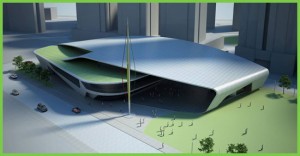The model for The Mind Museum at Taguig (Philippines) is gorgeous.
Christina Chaey’s Nov. 21, 2011 news bit about the museum for Fast Company notes a number of architectural features including one grass roof and another roof designed to prevent wind tunneling by directing gusts upward.
The Mind Museum’s About page lists five galleries,
- The Story of the Universe: Its Beginning and Majesty
- The Story of the Earth: Its Story Across the Breadth of Time
- The Story of Life: The Exuberant Varieties of Life
- The Story of the Atom: The Strange World of the Very Small
- The Story of Technology: The Showcase of Human Ingenuity
in an indoor exhibition area of approximately 3560 sq metres. There is also an 800 sq metre Science in the Park area immediately adjacent to the museum. (I’m betting they have some information about nanotechnology as part of the ‘Story of the Atom’.)
There were some 50 designers and scientists involved in this museum. The lead architect was Ed Calma of Lor Calma Design Inc. The museum was scheduled to open Dec. 15, 2011 and the event was covered by Dexter R. Matilla for the Philippine Daily Enquirer in a Dec. 21, 2011 article,
For so long, the arts have been the driving force for the city of the Bonifacio Global City (BGC). Larger-than-life pieces from some of the country’s top artistic names make up BGC’s Art Walk. With the opening of The Mind Museum at Taguig, it’s safe to say that the Arts and Sciences finally have a place all their own.
The Mind Museum was made possible through private donations from corporate sponsors, family and individual donors who believe in giving the Philippines a center for the public understanding of science, in particular science at its most basic.
“Science is all about understanding how things work,” said The Mind Museum’s managing director Manny Blas. “People need to understand the basic science. What is a cell or a DNA? What makes up the universe? How do telescopes or MRI work? If you understand the principles of science, you know how to apply it. If students can come in here and then go out and consider becoming a scientist or an engineer, then we would have done our job.”
…
The country’s first world-class science museum is a P1 billion project that had inputs in its planning stage from international experts like Jack Rouse and Associates and the Science Centre Singapore. Its futuristic yet organic design, however, is by a team of architects from Lor Calma & Partners headed by architect Ed Calma.
I gather the Dec. 15, 2011 opening is a ‘soft’ opening as the museum website notes that it is being opened to the public in March 2012.
